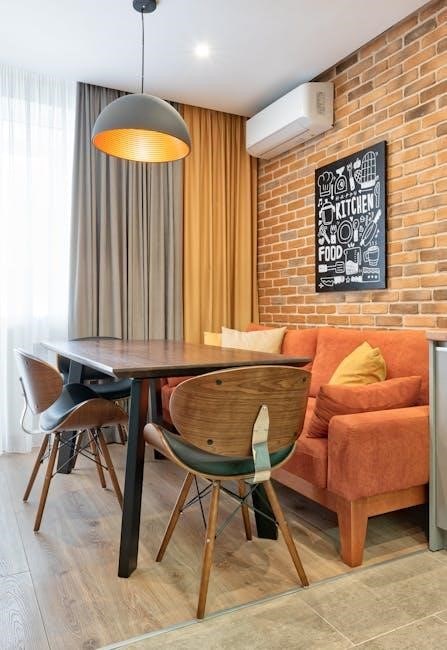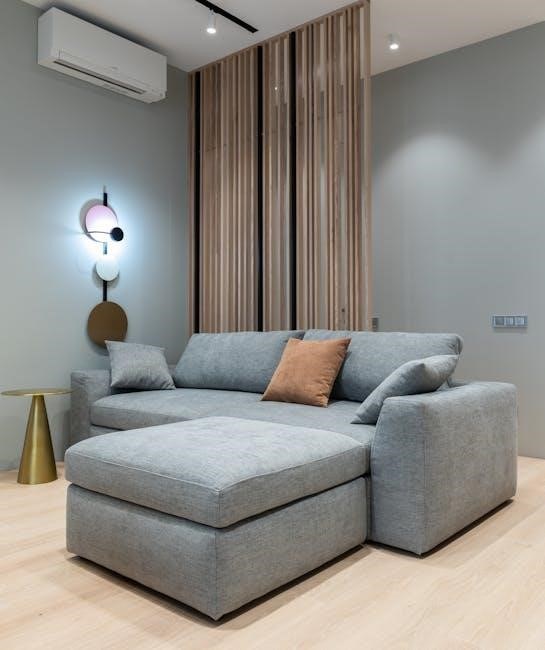Welcome to the Living Air Conditioner Manual, your comprehensive guide to understanding and optimizing your unit for efficient cooling. This manual covers essential features, installation, operation, and maintenance tips to ensure optimal performance while minimizing energy consumption. Designed to help you efficiently, effectively, and safely operate your air conditioner, this manual is a must-read for new users and experienced owners alike.
What is a Living Air Conditioner?
A living air conditioner is a modern, energy-efficient cooling system designed to provide optimal comfort in residential spaces. Unlike traditional AC units, it often features advanced technology such as smart sensors, eco-friendly refrigerants, and silent operation. These units are tailored for home environments, ensuring consistent temperature control while minimizing energy consumption. They may also include innovative features like air purification systems, humidity control, and Wi-Fi connectivity for remote operation. The primary goal of a living air conditioner is to enhance indoor air quality and comfort while being environmentally responsible. Its compact design and user-friendly interface make it a practical choice for homeowners seeking reliable and efficient cooling solutions.
Importance of Using a Manual for Your Living Air Conditioner
Importance of Using a Manual for Your Living Air Conditioner
Using a manual for your living air conditioner is essential for ensuring optimal performance, safety, and energy efficiency. It provides detailed guidance on installation, operation, and maintenance, helping you avoid common mistakes that could damage the unit or reduce its lifespan. The manual also includes troubleshooting tips to address issues quickly, minimizing downtime and saving you from costly repairs. By following the manual, you can optimize settings for better energy efficiency and understand advanced features like eco-mode or smart controls. Additionally, it serves as a reference for understanding safety precautions and proper usage, ensuring a secure and comfortable living environment. Regularly consulting the manual helps you maintain your air conditioner in peak condition, extending its longevity and performance.

Installation and Setup
Installing your living air conditioner requires careful planning and adherence to manufacturer guidelines to ensure safety and efficiency. Position the unit correctly, secure it firmly, and connect all components properly for optimal performance.
Unboxing and Preparing Your Living Air Conditioner
Unboxing your living air conditioner is an exciting first step toward enjoying a cooler, more comfortable space. Carefully open the package and inspect the unit for any visible damage. Ensure all accessories, such as the remote control, thermostat, and venting kit, are included. Before proceeding, read the manual thoroughly to familiarize yourself with the components and safety guidelines. Prepare a clean, dry, and flat surface for installation, ensuring it is level to prevent improper drainage or performance issues. Gather the necessary tools, such as a screwdriver or wrench, as specified in the manual. Proper preparation ensures a smooth installation process and optimal functionality of your air conditioner.
Choosing the Right Location for Installation
Selecting the right location for your living air conditioner is crucial for optimal performance and efficiency. Ensure the unit is installed near a power source to avoid the need for lengthy cords. Place it away from direct sunlight and heat sources, such as radiators or fireplaces, to prevent overheating. Avoid obstructing windows or doors, as proper ventilation and airflow are essential. Choose a location that allows the unit to circulate air evenly throughout the room. Ensure the surface is level and sturdy to support the weight of the conditioner. Finally, consider the unit’s size relative to the room to ensure it can effectively cool the space. Proper placement enhances efficiency and prolongs the unit’s lifespan.
Understanding Venting Options and Requirements

Proper venting is essential for your living air conditioner to function efficiently and safely. Most units require venting to expel hot air outside, ensuring optimal cooling performance. Single-hose systems are common, while double-hose systems offer better efficiency by separating intake and exhaust. No-vent systems are also available but may have limitations. Always follow the manufacturer’s guidelines for venting kits and installation to avoid damage or reduced performance. Improper venting can lead to safety hazards, such as carbon monoxide buildup or reduced cooling capacity. Ensure vents are clear of obstructions and securely connected to maintain airflow. Regularly inspect and clean vents to prevent blockages. Proper venting ensures your air conditioner runs effectively while maintaining indoor air quality and safety. Always consult your manual for specific venting requirements tailored to your unit.
Step-by-Step Installation Guide
Installing your living air conditioner requires careful planning and execution to ensure optimal performance and safety. Begin by unboxing and inventorying all components, including the unit, mounting hardware, and venting kit. Choose a suitable location for the unit, ensuring it is level and well-ventilated. Next, attach the mounting bracket securely to the window or wall, following the manufacturer’s instructions. Carefully lift and place the unit into the bracket, ensuring it is stable and evenly aligned. Connect the venting system according to the manual, making sure all connections are tight to prevent air leaks. Plug in the unit and test all features to ensure proper functionality. Finally, double-check all installations for safety and efficiency. Always refer to your manual for specific guidelines, and consider professional assistance if unsure.

Operating Your Living Air Conditioner
Mastering your air conditioner’s operation ensures comfort and efficiency. Familiarize yourself with the control panel, thermostat, and remote for seamless temperature adjustments. Explore eco modes and energy-saving features to optimize performance while reducing energy consumption. Regularly check settings and adjust as needed to maintain desired comfort levels. Troubleshoot common issues promptly to avoid disruptions. Proper operation enhances longevity and efficiency, ensuring your space stays cool and comfortable year-round.
Understanding the Control Panel and Features
Your Living Air Conditioner’s control panel is designed for intuitive operation. It typically features buttons for power, temperature adjustment, fan speed, and mode selection. The LED display shows current settings, while indicators highlight active modes like cooling, heating, or eco mode. Use the remote control to adjust settings without moving from your spot. Some models include advanced features like timers, air quality sensors, and smart app integration. Familiarize yourself with each button’s function to optimize comfort and energy efficiency. Experiment with modes to find your preferred balance of cooling and energy savings. Regularly check the display for error codes or maintenance alerts to ensure smooth operation.
Setting Up and Using the Thermostat
To set up your Living Air Conditioner’s thermostat, start by turning it on and ensuring the display is active. Use the arrows or touchscreen to adjust the desired temperature, typically ranging from 60°F to 90°F. Set your preferred temperature and mode, such as Cool, Heat, or Fan. Energy-saving features like eco mode can be activated to optimize efficiency. For precision, enable smart sensors if available to detect room occupancy or temperature fluctuations. Regularly check and update settings to maintain comfort while reducing energy use. Proper thermostat setup ensures consistent cooling and heating, enhancing overall performance and extending the unit’s lifespan. Adjust settings seasonally to match your comfort needs and energy goals.
How to Use the Remote Control Effectively
Mastering your Living Air Conditioner’s remote control enhances convenience and efficiency. Start by ensuring the remote has clear line of sight to the unit. Use the power button to turn it on/off, and adjust temperature with the up/down arrows. The mode button lets you switch between cooling, heating, or fan settings. For quick adjustments, press the “Quick Cool” or “Quick Heat” buttons. The timer function allows you to set operation times, saving energy when not needed. Use the “Eco” button to activate energy-saving mode. Regularly replace the remote’s batteries for uninterrupted use. Explore all features to customize your comfort and optimize energy consumption. Proper remote usage ensures seamless control over your air conditioner’s performance.
Exploring Eco Mode and Energy-Saving Features
Your Living Air Conditioner is equipped with an Eco Mode designed to optimize energy consumption while maintaining comfort. This mode automatically adjusts temperature and fan speed to reduce power usage. Additionally, features like timers and smart sensors help minimize energy waste by turning off the unit when the room is unoccupied or when the desired temperature is reached. Using these settings can significantly lower your utility bills and environmental impact. To maximize efficiency, pair Eco Mode with a programmable thermostat and ensure proper unit maintenance. By leveraging these energy-saving tools, you can enjoy a cooler, more sustainable living space without compromising performance. Regularly review and adjust settings to tailor energy use to your lifestyle.
Maintenance and Care
Regular maintenance ensures your Living Air Conditioner operates efficiently and extends its lifespan. Clean filters, check for blockages, and schedule professional inspections to keep it running smoothly.
Cleaning and Replacing Air Filters
Cleaning and replacing air filters is essential for maintaining your Living Air Conditioner’s performance and energy efficiency. Dirty filters can reduce airflow, increase energy consumption, and compromise indoor air quality. To clean the filters, turn off the unit, remove them, and gently brush off debris using a soft brush or vacuum cleaner. For more thorough cleaning, rinse with mild detergent and dry completely before reinstalling. Replace filters every 1-3 months, depending on usage, to ensure optimal functionality. Regular filter maintenance not only improves cooling efficiency but also helps prevent dust buildup and potential health issues. Always refer to your manual for specific filter replacement guidelines.
Drainage Management and Water Leakage Prevention
Proper drainage management is critical to prevent water leakage and ensure your Living Air Conditioner operates efficiently. Ensure the unit is installed on a level surface and the drain hose is securely connected to the drainage system. Regularly inspect the drain hose for blockages or kinks, as these can cause water to accumulate and leak. If you notice water pooling around the unit, check the drain pan and ensure it is properly positioned. For condenser models, verify that the drainage system is functioning correctly to prevent overflow. Addressing drainage issues promptly helps prevent damage to the unit and surrounding areas.
Caring for the Exterior Unit
Regular maintenance of the exterior unit ensures optimal performance and longevity. Clean the exterior casing with a soft cloth and mild detergent to remove dirt and grime. Avoid using abrasive materials that could damage the finish. Protect the unit from direct sunlight and harsh weather conditions by installing a shade or cover when not in use. Check for debris like leaves or twigs around the unit, as they can obstruct airflow and reduce efficiency. Ensure the unit is securely fastened to prevent vibrations or movement. For added protection, apply a waterproof cover during the off-season or in extreme weather. Regularly inspect the exterior for signs of rust or damage and address them promptly to maintain your Living Air Conditioner’s efficiency and lifespan.
Scheduling Professional Maintenance
Scheduling professional maintenance for your Living Air Conditioner is crucial for ensuring optimal performance, efficiency, and longevity. Regular servicing by a certified HVAC technician can identify and address potential issues before they escalate. Professional maintenance typically includes inspecting and cleaning internal components, checking refrigerant levels, and ensuring proper airflow. This not only improves cooling efficiency but also reduces energy consumption and prevents unexpected breakdowns. Schedule maintenance annually, preferably before the start of the cooling season, to ensure your unit operates at its best. A well-maintained system also extends its lifespan and reduces the risk of costly repairs. Always use authorized service providers to guarantee compliance with manufacturer guidelines and warranty terms.

Troubleshooting Common Issues
Identify and resolve common problems with your Living Air Conditioner by checking error codes, power supply, and filter cleanliness. Resetting the unit or contacting a technician may be necessary for persistent issues.
Identifying and Resolving Common Problems
Common issues with your Living Air Conditioner can often be resolved with simple troubleshooting. Start by checking the power supply and ensuring the unit is properly plugged in. If the unit isn’t cooling, inspect the air filters for dirt or blockages and clean or replace them as needed. Water leakage issues may indicate a clogged drain, which can be fixed by clearing the drain hose. Strange noises or vibrations could signal misaligned parts or loose screws, which should be tightened. For error codes, refer to the manual or contact customer support. Regular maintenance and timely repairs can prevent major breakdowns and extend the unit’s lifespan.

Understanding Error Codes and Alarms
Your Living Air Conditioner is equipped with a diagnostic system that displays error codes to alert you of specific issues. Common codes include E1 for temperature sensor malfunctions, E2 for refrigerant level issues, and E3 for compressor faults. When an error occurs, the unit may display the code on the control panel or emit a series of beeps. Refer to the manual for a detailed list of codes and their meanings. To resolve issues, turn off the unit, unplug it, and allow it to reset. For persistent problems, contact a certified technician. Regular maintenance can help prevent errors and ensure smooth operation. Always prioritize safety by addressing alarms promptly to avoid further damage or efficiency loss.
Dealing with Strange Noises or Vibrations
If your Living Air Conditioner produces unusual noises or vibrations, it may indicate an underlying issue. Common causes include loose screws, improper installation, or debris in the vents. Begin by turning off the unit and inspecting the exterior for obstructions. Ensure all bolts and screws are tightly secured, as vibrations can cause components to loosen over time. If the issue persists, check for misaligned fans or compressors, which may require professional adjustment. Regular cleaning of air filters and vents can also prevent unusual sounds. For persistent problems, consult the troubleshooting section or contact a certified technician. Addressing these issues promptly ensures smooth operation and extends the lifespan of your air conditioner.

Resetting Your Living Air Conditioner
Resetting your Living Air Conditioner can resolve various operational issues, such as error codes or unexpected shutdowns. Start by locating the reset button, usually found at the back or bottom of the unit. Press and hold the button for 10-15 seconds until the indicator light flashes. Release the button and wait for the unit to restart automatically. If the reset button is not accessible, unplug the unit from the power source, wait 30 seconds, and plug it back in. This process resets the system to its default settings. After resetting, test the unit to ensure proper functionality. If issues persist, refer to the manual or contact a professional technician for further assistance.
Energy Efficiency and Optimization
Maximize your Living Air Conditioner’s efficiency by adjusting thermostat settings, using Eco Mode, and ensuring proper maintenance. Regular filter cleaning and optimal venting also enhance performance while reducing energy consumption.
Optimizing Settings for Maximum Efficiency
To achieve maximum efficiency with your Living Air Conditioner, start by adjusting the thermostat to a moderate temperature range of 22–25°C (72–77°F) for cooling. Use the timer function to schedule operations, ensuring the unit runs only when needed. Enable Eco Mode to reduce energy consumption by limiting excessive cooling. Adjust fan speed settings to match room size and occupancy for optimal airflow. Regularly monitor and adjust settings via the remote control or smart app to maintain consistent comfort. Properly sealing windows and doors can also enhance efficiency. By fine-tuning these settings, you can significantly lower energy bills while maintaining a comfortable environment. Always refer to the manual for specific guidance tailored to your unit.

Comparing Different Operating Modes
Your Living Air Conditioner offers multiple operating modes to suit various cooling needs. The Cool Mode is ideal for lowering room temperature quickly, while Heat Mode provides warmth during colder months. The Fan Mode circulates air without cooling or heating, perfect for maintaining airflow. Eco Mode optimizes energy use by limiting excessive cooling or heating. Each mode is designed for specific scenarios, ensuring efficient operation; By understanding and selecting the right mode, you can balance comfort and energy savings. Regularly switching modes based on weather and occupancy can significantly reduce energy consumption and extend the unit’s lifespan. Always refer to the manual for detailed mode descriptions tailored to your model.
Tips for Reducing Energy Consumption
To minimize energy use, adjust your thermostat settings wisely and use the timer function to avoid unnecessary operation. Maintain consistent temperatures to reduce frequent cycling. Utilize fans to circulate air, allowing you to raise the temperature without discomfort. Ensure windows and doors are sealed to prevent cooled air from escaping. Regularly clean filters and coils to maintain efficiency. Consider upgrading to a smart thermostat for optimized control. By following these tips, you can significantly lower your energy consumption while keeping your space comfortable. Always refer to your manual for model-specific energy-saving features and recommendations.

Safety Precautions and Guidelines
Always follow safety guidelines to prevent accidents. Keep the unit away from water sources and ensure proper installation to avoid electric shock. Never handle refrigerant without training. Use OEM parts for repairs to maintain safety and performance. Follow these precautions for reliable operation.
Important Safety Information
Ensure safe operation by following essential guidelines. Keep the unit away from water sources to prevent electrical hazards. Avoid exposing the air conditioner to extreme temperatures or physical damage. Always disconnect power before performing maintenance. Use only approved refrigerants and follow proper handling procedures to avoid health risks. Install the unit on a stable, level surface to prevent tipping. Never modify or tamper with internal components, as this can lead to fire or electric shock. Keep children and pets away from moving parts. Regularly inspect cords and plugs for damage. Do not operate the unit near flammable materials. Follow all local regulations and safety standards for installation and use. Proper adherence to these guidelines ensures safe and reliable performance.

Handling Refrigerant and Avoiding Leaks
Properly managing refrigerant is crucial for the efficiency and safety of your living air conditioner. Always use the recommended type of refrigerant to avoid system damage. To prevent leaks, regularly inspect refrigerant lines for damage or wear, and ensure all connections are secure. If a leak is suspected, turn off the unit immediately to prevent further refrigerant loss and contact a professional for repairs. Avoid mixing different refrigerants, as this can cause operational issues. When handling refrigerant, wear protective gear like gloves and goggles. Store refrigerant cans safely, away from heat sources and open flames, and dispose of them responsibly to minimize environmental impact. Regular maintenance and timely repairs are key to maintaining optimal performance and safety.
Preventing Fire Hazards and Electrical Issues
To ensure safety, always follow guidelines for preventing fire hazards and electrical issues with your living air conditioner. Regularly inspect the power cord and plug for damage or fraying, and avoid using extension cords to minimize risks. Keep the unit away from flammable materials like curtains or furniture. Ensure proper installation by a licensed technician to prevent electrical malfunctions. Never overload circuits, and always use a grounded outlet to reduce the risk of electrical fires. If you notice unusual smells, sparks, or overheating, turn off the unit immediately and contact a professional. Regular maintenance can help identify and address potential hazards before they escalate. Always prioritize safety to protect your home and loved ones.
Thank you for completing the Living Air Conditioner Manual. Proper usage and maintenance ensure optimal performance. For further learning, explore additional resources like manufacturer guides or online tutorials.
Final Tips for Effective Use
To maximize your Living Air Conditioner’s performance, always clean filters regularly and ensure proper ventilation. Use eco-mode for energy efficiency and set the thermostat to optimal temperatures. Avoid overcooling by adjusting settings based on room size and occupancy. Regularly inspect for leaks and ensure the drain is clear to prevent water damage. For consistent cooling, maintain a stable thermostat setting and use the remote control to adjust settings conveniently. Lastly, refer to the manual for troubleshooting common issues and schedule annual professional maintenance for long-term efficiency. By following these tips, you can enjoy a comfortable and energy-efficient cooling experience year-round.
Recommended Additional Reading and Resources
For deeper insights and enhanced functionality, explore additional resources such as the official Living Air Conditioner Manual and manufacturer-provided guides. Visit the official website for downloadable PDF manuals, troubleshooting guides, and energy-saving tips. Check out online forums and reviews for user experiences and expert advice. Consider energy-efficiency publications from organizations like ENERGY STAR for optimizing your unit’s performance. Additionally, refer to local HVAC guidelines for maintenance and safety standards. These resources will help you maximize your air conditioner’s efficiency, extend its lifespan, and ensure safe operation. By leveraging these materials, you can become a more informed user and enjoy a cooler, more comfortable living space all year round.